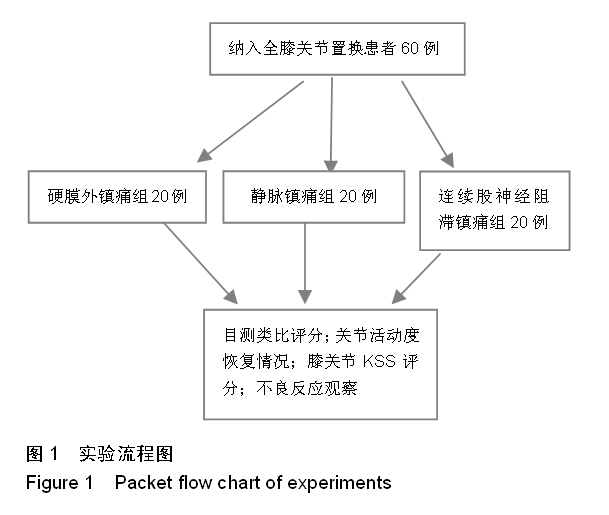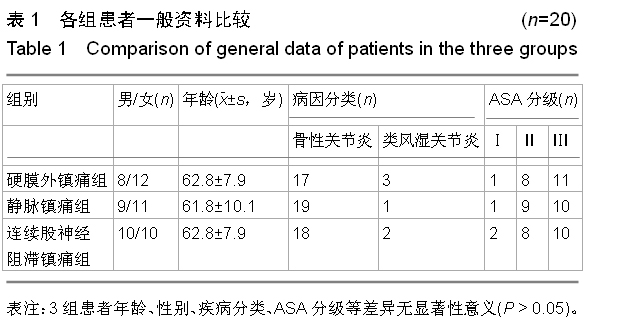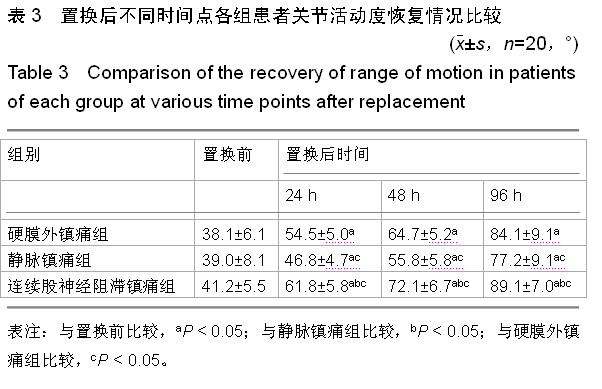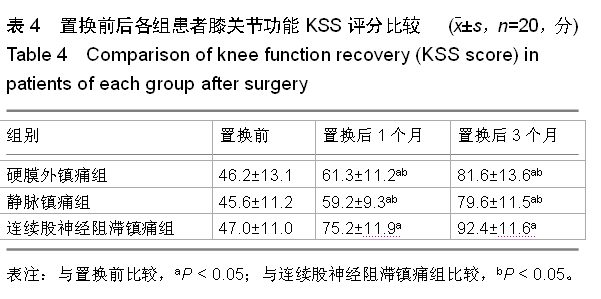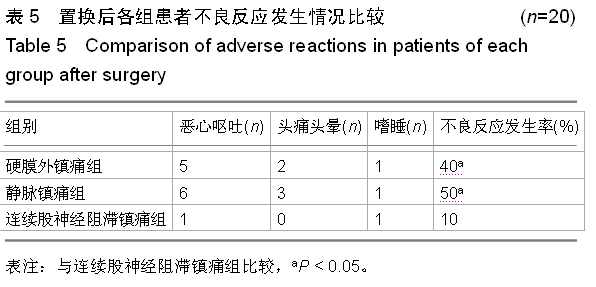| [1] Daneshvar P, Forster AJ, Dervin GF, et al. Accuracy of administrative coding in identifying hip and knee primary replacements and revisions. J Eval Clin Pract. 2012;18(3): 555-559.
[2] Jasvinder A, Singh MB, Gabriel MD, et al. The impact of gender, age and preoperative pain severity on pain after TKA. Clin Orthop Relat Res. 2008;466(11):2717-2723.
[3] Paul JE, Arya A, Hurlburt L, et al. Femoral nerve block improves analgesia outcollles after total knee arthroplasty: a meta-analysis of randomized controlled trials. Anesthesilogy. 2010;13(5):1144-1162.
[4] 郇松玮,姚平,刘宁,等.膝关节置换后不同镇痛方案的疗效评价[J].中国矫形外科杂志,2014,22(7):601-606.
[5] 蒋嘉,温洪,周权,等.不同镇痛方法对膝关节置换置换后疼痛和功能恢复的影响[J].临床麻醉学杂志,2014,30(5):437-440.
[6] 李东文,徐燕,吴海山,等.全膝关节置换后多模式围手术期疼痛控制方案在镇痛中的作用评价[J].中国组织工程研究与临床康复, 2007,11(36):7223-7226.
[7] 张伟,朱丰,胡焱,等.罗哌卡因股神经导管不同给药方式对置换后镇痛的影响[J].临床麻醉学杂志,2012,28(1):40-42.
[8] Choi PT, Bhandari M, Scott J, et al. Epidural analgesia for pain relief following hip or knee replacement. Cochrane Database Syst Rev. 2003;3:CD003071.
[9] Shanthanna H, Huilgol M, Manivackam VK, et al. Compararive study of ultrasound guided continuous femoral nerve blockade with continuous epidural analgesia for pain relief fol lowing total knee replacement. Indian J Anaesth. 2012;56(3):270-275.
[10] Raimer C, priem K, Wiese AA. Continuous psoas and sciatic block after knee arthroplasty: good effects compared to epidural analgesia or I.V.opioid analgesia: a prospective study of 63 patients. Acta Orthop. 2007;78(2):193-200.
[11] 高涛,耿立成.股神经和硬膜外自控镇痛在全膝关节置换后的效果比较[J].中国中西医结合外科杂志,2009,15(6):590-593.
[12] 张春燕,李清敏.人工膝关节置换患者多模式镇痛的临床观察[J].临床合理用药杂志,2014,7(1):98-99.
[13] Farag E, Dilger J, Brooks P, et al. Epidural analgesia improves early rehabilitation after total knee replacement. J Clin Anesth. 2005;17(4):281-285.
[14] Campbell A, McCormick M, McKinlay K, et al. Epidural vs. Lumbar plexus infusions following total knee arthroplasty: randomized controlled trial. Eur J Anaesthesiol. 2008;25(6): 502-507.
[15] 单海华,朱常花,谢红,等.超声引导下罗哌卡因连续股神经阻滞用于20例全膝关节置换后康复镇痛的疗效分析[J].重庆医学,2012, 41(13):1312-1314.
[16] 赵峰,王丹丹,杨光,等.连续腰丛神经阻滞或连续股神经阻滞用于全膝关节置换后镇痛的比较[J].临床麻醉学杂志,2013,29(2): 152-154.
[17] Marques EM, Jones HE, Elvers KT, et al. Local anaesthetic infiltration for peri-operative pain control in total hip and knee replacement: systematic review and meta-analyses of short and long-term effectiveness. BMC Musculoskelet Disord. 2014;15:220.
[18] Mahler SP, Adogwa AO. Anatomical and experimental studies of brachial plexus, sciatic, and femoral nerve-location using peripheral nerve stimulation in the dog. Vet Anaesth Analg. 2008;35(1):80.
[19] 王连主,刘慧,苏帆,等.超声引导在连续股神经阻滞行膝关节手术后镇痛中的应用[J].山东医药,2015,(1):80-81.
[20] 彭建光,沈惠良,曹光磊,等.连续股神经阻滞镇痛在TKA置换后康复锻炼中的应用初探[J].中国骨肿瘤骨病,2011,10(6):547-549.
[21] 戴文达,殷殿毅,李渊,等.连续股神经阻滞联合帕瑞昔布用于全膝置换后镇痛的效果评价[J].中国骨与关节外科,2013,6(1):17-20.
[22] Gemma M, Nicelli E, Gioia L, et al. Acupuncture accelerates recovery after general anesthesia: a prospective randomized controlled trial. J Integr Med. 2015;2:99-104.
[23] Liu SS, Zayas VM, Gordon MA, et al. A prospective, randomized, controlled trail comparing ultrasound versus nerve stimulator guidance for interscalene block for ambulatory shoulder surgery for postoperative neurological symptoms. Anesth Analg. 2009;109(1):265-271.
[24] Salinas FV. Location, location, location: continuous peripheral nerve blocks and stimulating catheters. Reg Anesth Pain Med. 2003;28(2):79-82.
[25] Liu SS, Ngeow JE, Yadeau JT. Ultrasound-guided regional anesthesia and analgesia: a qualitative systematic review. Reg Anesth Pain Med. 2009;34(1):47-59.
[26] 陈何伟,汤洪,刘志奇,等.右美托咪啶在连续股神经阻滞术中的应用观察[J].河北医药,2013,35(16):2486-2487.
[27] Khoo ST, Brown TC. Femoral nerve block: the anatomical basis for a single injection technique. Anaesth Intensive Care. 1983;11(1):40-42.
[28] 王春爱,赵振文,王承祥,等.局部浸润罗哌卡因联合静脉镇痛对全膝关节置换术后镇痛及早期康复的影响[J].临床骨科杂志, 2014, 17(3):274-276.
|
